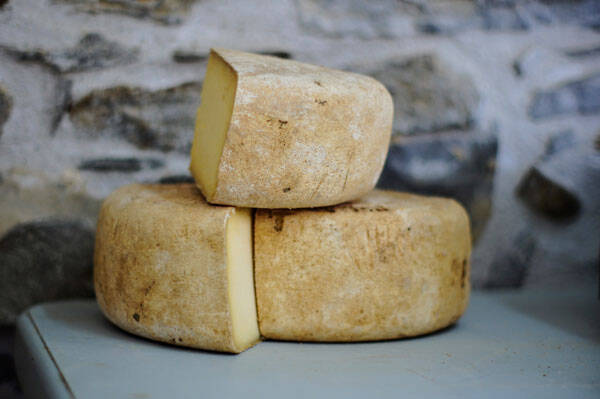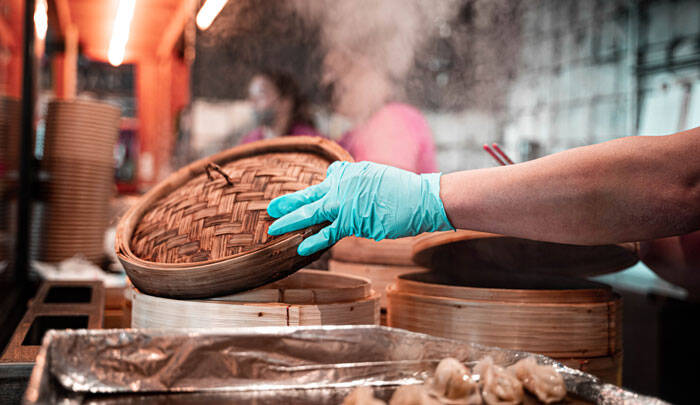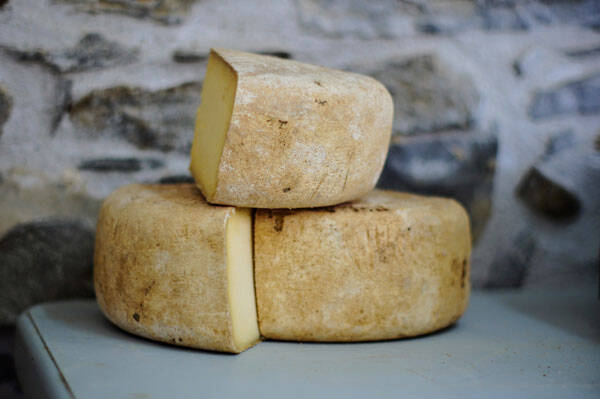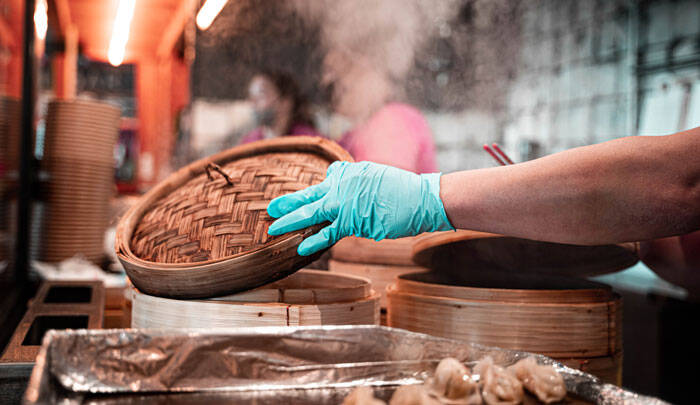The molecule octanol
Surprisingly, even the same single molecule can have different smells. The molecule octanol, present in for example mushrooms and kombu, is described as orange, mushroom and melon. Depending on the composition the molecule is part of, our personal sensitivities and previous encounters, we perceive the same molecule in entirely different ways.
Wine connoisseurs
Wine connoisseurs are probably most commonly adept at differentiating between smells. They often appreciate aromas that aren’t particularly liked in everyday life. Riesling wines, for example, share the molecule TDN with crude fossil fuels. Sauvignon Blanc releases sulfur-containing volatiles also found in cat urine.
The cosmetics industry
The cosmetics industry is a major source of knowledge of smells. It provides research on both human smells and fragrances, which sometimes end up in the food industry. McGee says that three laboratories identified molecules in human sweat that are described as smelling ‘meaty’ and ‘oniony’. One of the laboratories did not only make fragrances, but was also active in the food industry. Now they synthetically produce sweat molecules, and use them as food additives for enhancing meaty flavor.
Cilantro
Cilantro is a well known aroma that’s either hated or loved. This is partly due to genetic differences: some people are more sensitive to it than others. What’s less well known is that the defining volatiles are also the result of the chemical breakdown of soap and cosmetics. If your mind first makes the connection between these volatiles and cilantro, soap will remind you of coriander. The result is less pleasant in reverse, as foods will remind you of soap.
McGee focuses on the scientific side of the equation, but he gives plenty of intriguing examples of the power of subjective perception. A few:
A cheesy smell
McGee starts his book with a good example of his own experience. He recounts the time that he came back from a run, and smelled a stale and spoiled aroma. He checked the larder for rotten produce and the sink drain for blockage, then remembered he had set a soft-ripened cheese on the table to come to room temperature. Once he identified the source of the smell, and tasted the cheese, the stinky note seemed less powerful, and pleasant “milky, meaty and fruity aromas” became prominent. The association between cheese and less pleasant products makes sense, as soft cheeses actually share volatiles with dog skin and human feet! The fact that McGee saw the cheese, entirely changed his perception of the smell.



However, science is only half of the story of the world of smells (osmocosm as McGee calls it). Once the volatile molecules fly onto the receptors in our noses, our brains interpret them, in a subjective manner. Receptors pick up specific volatiles, and not everybody has the same ratio of receptors. Even more subjective is the reception of our brains. They make sense of the input using various sources of information, such as sight, touch and previous experiences. This context obviously differs per person and situation.
Science and perception
The science of smell is indeed that, a very real and objective science. Chemists are able to pinpoint smells to so called volatile molecules, which means ‘tending to evaporate’”. To a certain degree scientists are even able to describe what the earth smelled like at its earliest stages.
McGee explains that most molecules are too heavy to fly, or cling too strongly to other molecules. Volatiles are the exception, and escape their original body to fly into our noses. The smells that we recognize are an aggregation of a lot of different volatiles. Sciences like biology explain why these volatiles came to be. Some are the result of a purposeful process. What we recognize as the familiar smells of rosemary and thyme, is in fact chemical warfare. The plants produce the volatiles to become unpalatable to animals. Eating a sprig of rosemary stings to rabbits, and to us! Diluted however, they provide a pleasant aroma. Other smells are unintended. For example, unmanaged microorganisms may break down fruits or milk, which we call spoilage, to provide energy for themselves. Various volatiles are the result of this process. Not useful for the microorganism, but definitely smellable by us.
In Nose Dive McGee guides readers through the world of smells, explaining why things smell like they do. In this journey, an interesting contrast appears between our perception and the science of smells.
The smell of food is a powerful element in our eating experiences, both in a positive and negative way. The smell of fresh bread evokes a sense of homeliness, cut grass of summer picnics. Strong smells might discourage us to eat something, which is sensible in some cases, a missed opportunity in others. Still, smell is an afterthought in most kitchens. Food writer Harold McGee sets out to change this way of working, with his book Nose Dive.
Jurgen Elenbaas Xiao Er Kong
An exploration of Harold McGee’s Nose Dive
Our perception of smell


4 min
expert opinion
our perception of smell

The molecule octanol
Surprisingly, even the same single molecule can have different smells. The molecule octanol, present in for example mushrooms and kombu, is described as orange, mushroom and melon. Depending on the composition the molecule is part of, our personal sensitivities and previous encounters, we perceive the same molecule in entirely different ways.
Wine connoisseurs
Wine connoisseurs are probably most commonly adept at differentiating between smells. They often appreciate aromas that aren’t particularly liked in everyday life. Riesling wines, for example, share the molecule TDN with crude fossil fuels. Sauvignon Blanc releases sulfur-containing volatiles also found in cat urine.
The cosmetics industry
The cosmetics industry is a major source of knowledge of smells. It provides research on both human smells and fragrances, which sometimes end up in the food industry. McGee says that three laboratories identified molecules in human sweat that are described as smelling ‘meaty’ and ‘oniony’. One of the laboratories did not only make fragrances, but was also active in the food industry. Now they synthetically produce sweat molecules, and use them as food additives for enhancing meaty flavor.
Cilantro
Cilantro is a well known aroma that’s either hated or loved. This is partly due to genetic differences: some people are more sensitive to it than others. What’s less well known is that the defining volatiles are also the result of the chemical breakdown of soap and cosmetics. If your mind first makes the connection between these volatiles and cilantro, soap will remind you of coriander. The result is less pleasant in reverse, as foods will remind you of soap.
McGee focuses on the scientific side of the equation, but he gives plenty of intriguing examples of the power of subjective perception. A few:
A cheesy smell
McGee starts his book with a good example of his own experience. He recounts the time that he came back from a run, and smelled a stale and spoiled aroma. He checked the larder for rotten produce and the sink drain for blockage, then remembered he had set a soft-ripened cheese on the table to come to room temperature. Once he identified the source of the smell, and tasted the cheese, the stinky note seemed less powerful, and pleasant “milky, meaty and fruity aromas” became prominent. The association between cheese and less pleasant products makes sense, as soft cheeses actually share volatiles with dog skin and human feet! The fact that McGee saw the cheese, entirely changed his perception of the smell.



However, science is only half of the story of the world of smells (osmocosm as McGee calls it). Once the volatile molecules fly onto the receptors in our noses, our brains interpret them, in a subjective manner. Receptors pick up specific volatiles, and not everybody has the same ratio of receptors. Even more subjective is the reception of our brains. They make sense of the input using various sources of information, such as sight, touch and previous experiences. This context obviously differs per person and situation.
Science and perception
The science of smell is indeed that, a very real and objective science. Chemists are able to pinpoint smells to so called volatile molecules, which means ‘tending to evaporate’”. To a certain degree scientists are even able to describe what the earth smelled like at its earliest stages.
McGee explains that most molecules are too heavy to fly, or cling too strongly to other molecules. Volatiles are the exception, and escape their original body to fly into our noses. The smells that we recognize are an aggregation of a lot of different volatiles. Sciences like biology explain why these volatiles came to be. Some are the result of a purposeful process. What we recognize as the familiar smells of rosemary and thyme, is in fact chemical warfare. The plants produce the volatiles to become unpalatable to animals. Eating a sprig of rosemary stings to rabbits, and to us! Diluted however, they provide a pleasant aroma. Other smells are unintended. For example, unmanaged microorganisms may break down fruits or milk, which we call spoilage, to provide energy for themselves. Various volatiles are the result of this process. Not useful for the microorganism, but definitely smellable by us.
In Nose Dive McGee guides readers through the world of smells, explaining why things smell like they do. In this journey, an interesting contrast appears between our perception and the science of smells.
The smell of food is a powerful element in our eating experiences, both in a positive and negative way. The smell of fresh bread evokes a sense of homeliness, cut grass of summer picnics. Strong smells might discourage us to eat something, which is sensible in some cases, a missed opportunity in others. Still, smell is an afterthought in most kitchens. Food writer Harold McGee sets out to change this way of working, with his book Nose Dive.
Jurgen Elenbaas Xiao Er Kong
An exploration of Harold McGee’s Nose Dive
Our perception of smell

4 min










